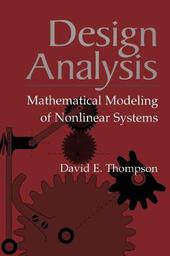
|
Design Analysis: Mathematical Modeling of Nonlinear Systems
Hardback
Main Details
| Title |
Design Analysis: Mathematical Modeling of Nonlinear Systems
|
| Authors and Contributors |
By (author) David E. Thompson
|
| Physical Properties |
| Format:Hardback | | Pages:296 | | Dimensions(mm): Height 254,Width 178 |
|
| Category/Genre | Technical design
Mechanical engineering |
|---|
| ISBN/Barcode |
9780521621700
|
| Classifications | Dewey:620.0042 |
|---|
| Audience | | Tertiary Education (US: College) | | Professional & Vocational | |
|---|
| Illustrations |
Worked examples or Exercises; 31 Tables, unspecified; 147 Line drawings, unspecified
|
|
Publishing Details |
| Publisher |
Cambridge University Press
|
| Imprint |
Cambridge University Press
|
| Publication Date |
13 January 1999 |
| Publication Country |
United Kingdom
|
Description
An integral part of engineering design is the development of models that describe physical behavior or phenomena in mathematical terms. As engineering systems have become more complex, classic linear methods of modeling and analysis have proved inadequate, creating a need for nonlinear models to solve design problems. This text provides an introduction to mathematical modeling of linear and nonlinear systems, with an emphasis on the solution of nonlinear design problems. While encouraging the use of the computer as a tool for modeling and analysis, the aim is to discuss the basic concepts underlying computer techniques and to seek analytical solutions. Among topics covered are exact solution, numerical solution, graphical solution, and approximate solution methods; and the stability of nonlinear systems. Numerous examples show how to apply modeling methods to real engineering systems. The book also includes end-of-chapter problems and case studies of challenging design problems. Intended for senior or beginning graduate students, this text will also serve as a helpful reference for practicing engineers.
Reviews'This is a textbook intended for senior undergraduate or beginning graduate students. It is well written and carefully organized. The author intention is to teach students how to formulate and solve the problem. By both, the choice of problems and by the selection of those problems, it is a unique book. I believe that it would be very useful for every student to read this book or to take course where this book is used, before he or she chooses field for graduate studies in engineering. The variety of problems treated and the methods of solutions used would help student select his or her own field of research. In conclusion, this is an excellent undergraduate textbook for engineering students.' T. M. Atanackovic
|